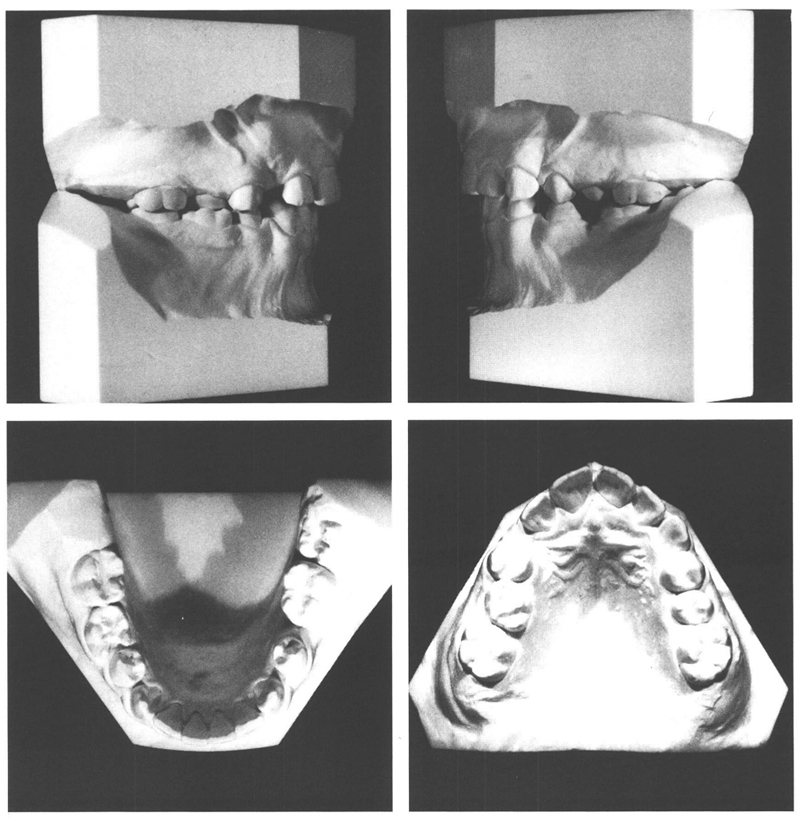Class II/1, agenesis 35
Extraction 75, cervical headgear, maxillary removable plate
Female: 8 years, 7 months to 34 years 0 months
A girl aged 8 years and 7 months exhibited a class II/1 anomaly with normal function; she occasionally sucked her thumb. She could breathe easily through her nose and usually kept her lips together. The mandibular left second premolar was congenitally absent and some of the deciduous molars were carious. In the maxilla, the right deciduous canine had exfoliated prematurely and the permanent incisors had drifted to the right. Consequently the middle of the maxillary dental arch was located 2mm too far to the right (Fig. 31.1). The prognosis for the mandibular left second deciduous molar was unfavorable: the crown was carious and the roots were resorbed to about the same extent as those of the contralateral tooth despite there being a successor erupting beneath the latter (Fig. 31.13). Since there was normal lip closure and a disto-occlusion of just half a premolar crown width, early intervention was not indicated. Therefore it was decided to postpone orthodontic treatment for a few years and in the meantime to proceed with the extraction of the mandibular left second deciduous molar. In the second transitional period, a cervical headgear would be used to correct the disto-occlusion and to increase the space available for the maxillary right canine. It was expected that the mandible would not need active treatment, but that a removable plate would be needed in the maxilla in addition to the headgear.

Fig 31-1 Dental casts of a girl aged 8 y, 7 mo with a class II/1 anomaly and disto-occlusion on the right of ¾ PW and on the left of ½ PW (the facial and intraoral photographs are missing). The mandibular dental arch shows no abnormality, except a reduction in the arch length due to caries of the deciduous molars. Anteriorly there is excess space, while the mandibular left second premolar is congenially absent. The maxillary arch is narrow, the maxillary right deciduous molars occlude in crossbite, the maxillary right canine has exfoliated prematurely and partly due to the incisors having drifted to the right, the space for its successor is inadequate. The overjet is only slightly greater than normal because the disto-occlusion is combined with a deficiency in the maxillary arch length.
At the age of 9 years, 2 months, the mandibular left second deciduous molar was removed. Two years later, a cervical headgear was fitted. By that time, the first permanent molar in the third quadrant had drifted mesially and also tilted a little to lingual. Furthermore, the second permanent molar and the first premolar in that quadrant had emerged. The premolar had large diastemata mesially and distally. In the maxilla, the transition of the posterior teeth was complete on the left, with the first premolar emerging in a good transverse occlusion on the right. The space available for the right canine had increased somewhat (Fig 31.2).

Fig 31-2 At the age of 11 y, 2 mo, two years after extraction of the mandibular left second deciduous molar, the first permanent molar on that side has drifted mesially and tipped a little lingually. Large diastemata can be seen on either side of the mandibular left first premolar. The mandibular left second permanent molar has emerged early. The mandibular right second deciduous molar has lost so much of its crown from caries that it now is the same width as its successor. (In the 1960s, carious deciduous teeth were seldom restored and often not extracted either.) In the maxilla, the premolars and canines have emerged without problems on the left. On the right, the second deciduous molar is still present and the first premolar has come into good transverse occlusion. The right permanent canine has only 3 mm space available for it in the arch, while the spaces in the anterior part of the arch have gone.
After one year and three months, the disto-occlusion had been corrected and there was almost sufficient room for the maxillary permanent canine to take its place, although it had emerged rather too far mesially (
Stay updated, free dental videos. Join our Telegram channel

VIDEdental - Online dental courses


